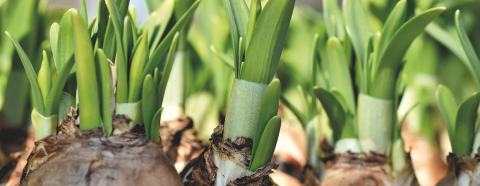March Gardening Tips II

Spring bulbs may start appearing earlier than expected if the soil is bare and the temperatures are warmer than usual.
Most bulbs start to come up in March and April, but early emergence is not a cause for concern. Early leaf development may be damaged by freezing temperatures but as long as the flower buds remain below ground during colder temperatures they should flower as expected. If the buds emerge and are killed by the cold, the plant will likely survive and return to flower production the following season. A thick layer of organic mulch such as leaves, pine needles, or bark mulch, applied in late fall can help insulate the bulbs and keep them from emerging prematurely.
Pruning bigleaf hydrangea (Hydrangea macrophylla), also called mopheads or lacecaps, is best done after new growth appears in spring.
Pruning before leaf development is a real challenge because the living and dead stems can look very similar. Once the bush has developed leaves on the living stems the dead ones will stand out as leafless sticks. These should be pruned ¼” above the first set of live buds on that stem. Entirely dead stems should be cut flush with the ground or base of the plant. Flowers develop from buds on the wood of the previous year so harsh winter weather can cause significant bloom reductions. Winter protection with mulch or burlap wrapping can provide the cover needed to greatly reduce bloom loss.
Wildflowers and ornamental grasses can be cut down to within a few inches of the ground in early spring before new growth appears.
If you already cut them in the fall you may want to consider leaving them through the winter for next year. Spent flower heads can provide seed as a food source for wildlife and the dead stalks can be used as cover and concealment. Cut ornamental grasses can be used as mulch, composted, or left on the ground to decompose and return nutrients to the soil. Wildflowers can be left where they were cut and any uneaten seeds may find soil, germinate, and start a new population of flowers.
Mud season occurs when the top layer of soil thaws while the deeper soils are still frozen and the water has nowhere to drain leaving a thick layer of mud on the surface.
This can occur in your lawn, garden, or gravel driveway so be careful when using equipment, tools, and machinery in the spring. The soft upper layer will readily give way and create muddy ruts that may need to be renovated or reseeded. Tread lightly and give the soil time to drain before using heavy equipment. Mud season typically only lasts a couple weeks so be patient to avoid the extra work associated with lawn and garden damage.
Home invading insects such as the western conifer seed bug and multi-colored Asian ladybug may start appearing in large numbers in your home as temperatures begin to rise.
They are mostly considered a nuisance and pose no real threat to the homeowner. They can release an unpleasant odor when handled or crushed so gentle handling of the insects will help avoid this problem. They can be captured and released outdoors or vacuumed if they need to be removed. Insecticides are not recommended for treatment. Exclusion is the best way to prevent future infestations. Identify and seal up and gaps, cracks, or openings in windows, doors, and walls. Remove air conditioners from windows as soon as possible in fall as they often have large gaps around the installation site which is the perfect opening for entry.
Spring is a great time to apply lime.
Once the soil has thawed and can be worked, follow the recommended rate of application on your soil test results and work the lime into the top few inches of soil. Lime takes a relatively long time to break down and raise the pH, so the sooner you can incorporate it into the soil the better. Pelletized and granular/agricultural lime, are both economical sources and take about the same amount of time to break down and adjust the pH. It is important to have your soil tested every 2-3 years to monitor changes in pH and reduce or eliminate lime applications once optimal levels are achieved. A lab test can be done for just pH but a complete soil test is more helpful for monitoring overall soil health over time.
Do you love learning about stuff like this?
SUBSCRIBE TO GRANITE STATE GARDENING
A monthly newsletter for New Hampshire gardeners, homesteaders and plant-lovers of all kinds, that includes seasonal suggested gardening tips, upcoming events and articles with proven solutions for your garden and landscape.
Got questions? The Ask UNH Extension Infoline offers practical help finding answers for your home, yard, and garden questions. Call toll free at 1-877-398-4769, Monday to Friday, 9 a.m. to 2 p.m., or e-mail us at answers@unh.edu.
